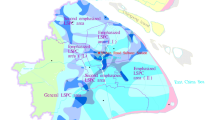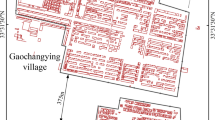Abstract
The article describes how current risk assessment of pressure mining using the “water inrush coefficient method” based on the Down Three Zones Theory is relatively inconsistent with the facts in practice. Based on the Down Three Zones Theory, the intact aquiclude is divided into a water pressure-free zone and a water pressure zone, and four kinds of mining discriminant models containing pressure are summarized by analyzing the influence of the confined groundwater on the intact aquiclude, according to the effect on its spatial characteristics. The relationship between the ratio of water head loss and permeability coefficient in the process of confined water conduction is obtained by building laboratory experiment model, and the height of water pressure zone is determined. The discriminant models are verified using the 81004 working face of the Caozhuang mine field in the Feicheng coalfield. The discriminant model results agree with the actual situation in the field and can be used to evaluate whether a coal seam can be safely mined.








Similar content being viewed by others
References
Bai CHG, Li LJ, Yu XF (1997) Cusp catastrophe model for instability of key stratum in floor with water inrush. J China Coal Soc 22(2):149–154
Bian K, Yang ZHB. (2016) Orthogonal test of the influential factors of confined water-conducting zone in coal floor. Coal Geology & Exploration 44(1):74–78
Gao WF, Shi LQ, Zhai PH (2019) Water detection within the working face of an underground coal mine using 3D electric resistivity tomography (ERT). J Environ Eng Geophys 24(3):497–505
Hu WY, Tian G, Li KK (2008) The resistant mechanism and control factors of coal seam floor aquiclude to high pressure water intrusion. Coal Geology & Exploration 36(6):38–41
Kuscer D (1991) Hydrological regime of the water inrush into the Kotredez coal mine (Slovenia, Yugoslavia). Mine Water Environ 10:93–101
Kuznetsov S, Trofimov V (2002) Hydrodynamic effect of coal seam compression. J Min Sci 38(3):205–212
Li BY (1999) “Down Three Zones” in the prediction of the water inrush from coalbed floor aquifer-theory, development and application. J Shandong Inst Min Technol (Nat Sci) 18(4):11–18
Li LJ, Qian MG, Wen Q, Meng YP (1995) Relationship between the stability of floor structure and water-inrush from floor. J China Univ Min Technol 4:18–23
Liu Q, Sun YJ, Xu ZM (2011) Application of modified water inrush coefficient method to evaluation of water inrush from mine floor. Coal Sci Technol 39(8):107–109
Motyka J, Pulido-bosch A (1985) Karstic phenomena in calcareous-dolomitic rocks and their influence over the inrushes of water in lead-zinc mines in Olkusz region (South of Poland). Int J Mine Water 4(2):1–11
Munirathinam M, Yinling JC (1994) A review of computer-based truck dispatching strategies for surface mining. Reclam Environ 8:1–15
Qiao W, Li WP, Zhao CX (2009) Water inrush coefficient-unit inflow method for water inrush evaluation of coal mine floor. Chin J Rock Mech Eng 28(12):2466–2474
Qu XY, Qiu M, Liu JH, Niu ZC, Wu XS (2019) Prediction of maximal water bursting discharge from coal seam floor based on multiple nonlinear regression analysis. Arab J Geosci 12:567
Sammarco O (1986) Spontaneous inrushes of water in underground mines. Int J Mine Water 5(3):29–41
Shi LQ, Han J (2005) Theory and practice of dividing coal mining area floor into fore-zone. J China Univ Min Technol 34(1):16–23
Shi LQ, Tan XP, Wang J, Ji XK, Niu CH, Xu DJ (2015) Risk assessment of water inrush based on PCA_Fuzzy_PSO_SVC. J China Coal Soc, 2015 40(1):167–171
Shi LQ, Wang Y, Qiu M, Gao WF, Zhai PH (2019a) Application of three-dimensional high-density resistivity method in roof water advanced detection during working stope mining. Arab J Geosci 12:464
Shi LQ, Wang Y, Qiu M, Han L, Zhao YP (2019b) Research on the required width of a fault waterproof coal pillar based on underground pressure control theory. Arab J Geosci 12:480
Shi LQ, Wang Y, Qiu M, Wang M (2019c) Assessment of water inrush risk based on the groundwater modeling system—a case study in the Jiaojia Gold Mine Area, China. Arab J Geosci 12:807
Shi LQ, Xu DJ, Wang Y, Qiu M, Hao J (2019d) A novel conceptual model of fracture evolution patterns in the overlying strata during horizontal coal seam mining. Arab J Geosci 12(10):1–9
Wang DD, Shi LQ (2019) Source identification of mine water inrush: a discussion on the application of hydrochemical method. Arab J Geosci 12(2):58
Wang LG, Song Y (2002) Study on the self-organized critical character for water burst from coal floor. Chin J Rock Mech Eng 21(2):1205–1208
Wang Z, Liu H (1994) Analysis and calculation of ultimate hydraulic resistance of residual intact rock mass in floor space. Chinese Journal of Rock Mechanics and Engineering (04):319–326
Wang ZY, Liu HQ, Wang PY, Yu SHC (1991) Theory and practice of coal mining discipline on confined water. J China Coal Soc 19(1):40–48
Wang JM, Ge JD, Wu YH (1996) Mechanism on progressive intrusion of pressure water under coal seams into protective aquiclude and application in prediction of water inrush. J China Univ Min Technol 2(2):9–15
Wang XY, Wang TT, Wang Q, Liu XM, Li RZ, Liu BJ (2017) Evaluation of floor water inrush based on fractal theory and an improved analytic hierarchy process. Mine Water Environ 36(1):87–95
Wang XY, Yang G, Wang Q, Wang JZ, Zhang B, Wang JW (2019) Research on water-filled source identification technology of coal seam floor based on multiple index factors. Geofluids 2019:5485731 9 pages
Wolkersdorfer C, Bowell R (2004) Contemporary reviews of mine water studies in Europe. Mine Water Environ 23(4):161
Yang TH, Liu HL, Zhu WC, Meng ZP, Wang R (2011) Modification and application of critical water outburst coefficient in coal mine based on the concept of effective stress. Chin J Rock Mech Eng 30(sup.2):4011–4018
Yin HY, Zhou WF, La Moreaux JW (2018) Water inrush conceptual site models for coal mines of China. Environ Earth Sci 77:746
Yu XG, Han J, Shi LQ, Wang Y, Zhao YP (2017) Application of a BP neural network in predicting destroyed floor depth caused by underground pressure. Environ Earth Sci 76:353
Zhang JC, Liu TQ (1990) On depth of fissured zone in seam floor resulted from coal extraction and its distribution characteristics. J China Coal Soc 15(2):46–54
Zhang WQ, Zhang GP, Li W et al (2013) A model of Fisher’s discriminant analysis for evaluating water inrush risk from coal seam floor. J China Coal Soc 38(10):1832–1836
Acknowledgments
The authors would like to thank the workers of the Department of Geology in the Feicheng coal mine for their field test and data collection.
Funding
This research was financially supported by the National Science Foundation (51778351), SDUST Research Fund (No.2018TDJH101), Scientific Research Development Plan of Colleges and Universities in Shandong Province, and Taishan Scholars Construction Projects Funded by Special Funds.
Author information
Authors and Affiliations
Corresponding author
Additional information
Responsible Editor: Murat Karakus
Rights and permissions
About this article
Cite this article
Shi, L., Qu, X., Yu, X. et al. Theory and practice on the division of the “water pressure-free zone” in a mining coal seam floor. Arab J Geosci 13, 1079 (2020). https://doi.org/10.1007/s12517-020-06067-2
Received:
Accepted:
Published:
DOI: https://doi.org/10.1007/s12517-020-06067-2




